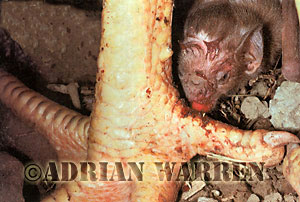Diaemus feeding on a chicken
For our base in Trinidad, we decided to use an abandoned research station in the Arima valley in the northern range of attractively forested mountains. The station had originally been established in the 1930s by Dr. William Beebe for the New York Zoological Society and had good facilities for keeping bats for observational purposes: indeed, much of the important original research work on bat radar, or echolocation, had taken place there. The building had been deserted for many years but some renovation had begun prior to its being reopened for use by field biologists. But it was still charmingly ramshackle with creaky doors, cobwebs, old brass beds and its own colony of fruit bats in the house, which flew through the main hall at dusk and at dawn: a suitable, and spooky, setting for a film about vampires.
The next problem was to find a friendly farmer with animals under regular attack. This was not easy: like their supernatural cousins, vampire bats tend to home in on some individuals but leave others mysteriously unmolested. Farmers with great numbers of cattle and other livestock were of no interest to us since it would have been to difficult to isolate, for filming purposes, an individual attack. We needed to find a farmer with a smallholding, but most are careful to seal off their precious animals at night to protect them. However, we eventually managed to find a donkey that was being attacked almost nightly in an open stall. For several nights nothing happened; it seemed that while our presence was of obvious benefit to the donkey, our hopes of filming the vampires were beginning to fade. During our nightly vigils we would switch on the lights from time to time to see if anything was happening and we could only presume that this was creating sufficient disturbance to keep the vampires away. What we had not considered was the moon. So far the nights had been clear and brightly moonlit; on these nights vampires stay in the shadows, attacking prey in dark shelters or in the forest.
On the first overcast night at the donkey's stall, it all happened, and it took us completely by surprise. A dark shape had moved in towards one of the donkey's hoofs. When we switched on the light, it scuttled back into the darkness but to our delight came back again, at first slowly and cautiously, but then more purposefully. We were working with very low light levels and Martin Saunders, the cameraman, was only just managing an exposure with a very fast lens. As the bat moved in, Martin started the camera. Later that same night we filmed a second vampire attacking the donkey's ear. At four o'clock in the morning we returned to the creaky old house in the mountains bursting with satisfaction at having something on film, we hoped. If it proved to be technically good then this was the first time that vampires had ever been filmed feeding on a victim. The following night we returned again to try for more; and again we were lucky: the bats came and this time we were able to observe their technique more closely.

